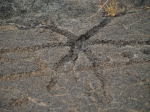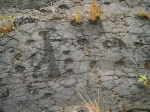
by Donnie MacGowan
Lost in the dreaming mists of time are the origins and meanings of Hawaiian petroglyphs, the carved rock art of the ancient Hawaiians. Are they religious symbols or hunting magic? Accounts of journeys and conquests? No one is certain, as no historical records exist and those kahuna who knew the meaning of their magic took those secrets to their grave.
Anthropomorphic Petroglyph from, the Makaole'a Beach, Kona: Photo by Donnie MacGowan

Like most animists, Hawaiíians invested worship and respect in, and intuited spiritual powers to, a range of natural objects and phenomena: rain, volcanic eruptions, the sea, sharks, fresh water springs, surf and individual rocks. Pohaku O Kane, or sacred rocks, were among the most common spiritual objects of worship, whether they were naturally occurring in the landscape (pohakuia loa), rocks set on platforms (pohaku amakua), carved rocks (pohaku iki) or the petroglyphs themselves (k'i'i pohaku). Petroglyphs from Pu'u Loa, Hawaii Volcanoes National Park: Photo by Donnie MacGowan
Most petroglyphs in the Hawaiian Islands are found in fields, on broad expanses of smooth pahoehoe basalt which would have facilitated both carving the images as well as gatherings of celebrants, were they later used in sacred rituals. The biggest petroglyph fields are found on the island of Hawaii, with the field at Pu'u Loa in Hawaii Volcanoes National Park being the largest petroglyph field in all of Polynesia. In addition to the various petroglyph fields, smaller scattered groups and lone carvings are known throughout the Hawaiian Islands. A black market exists in stolen petroglyphs and these lone petroglyphs, although many are well known and documented, are becoming increasingly hard to protect from thieves. Heartbreakingly, most of the targeted petroglyphs are destroyed as ignorant thieves try to pry, hammer and chip them away from their native stone.Elaborate Anthropomorphic Carving from Pu'u Loa Petroglyph Field: Photo by Donald B. MacGowan
Although the age of the petroglyphs is difficult to determine, a stylistic evolution is clearly evident and can even be relatively dated where more recent petroglyphs are carved directly on top of older ones. The styles start with simple stick figures and crude geometric shapes and evolve into more humanoid figures with triangular chests. Carvings with elaborate headdresses and complex geometric designs came later and carvings of horses, cattle and European sailing vessels are the most recent and certainly post-date European contact. There are many petroglyphs which seem to defy even these simple classifications and are so stylistically unique that scholars argue whether they represent some variant art form that flourished briefly and died, or are a more modern carving by contemporary artists.Simple Geometric Carving from Pu'u Loa: Photo by Donnie MacGowanA More Complex Geometric Carving from Pu'u Loa: Photo by Donnie MacGowan
Puako Petroglyph Field
The right hand raised in this figure from Puako Petroglyph Field may indicate the compass direction "North West": Photo by Donnie MacGowan

This enormous field of over 1200 individual carvings makes you wonder why ancient Hawaiíians made their tortuous way across miles of inhospitable lava desert, far from any source of water and through thick keawe forest to leave their enigmatic and cryptic petroglyphs on this singular Pahoehoe lava flow. Carved between 1000 and 1800c.e., the Puako Petroglyph Field is the second largest field of ancient petroglyphs in Polynesia. Lying near the grounds of the Mauna Lani Resort, they are accessed today by a simple, 25-minute walk on the wide, easy Malama Trail. The meaning and message of these petroglyphs have never been divined, but in addition to the stone pictures, are numerous piko, small holes bored into the lava to accept an infantís umbilical cord during the religious birth ceremonies.
Puako has offered at least one clue in unraveling the enigma of Hawaiian petroglyphs. Based upon thousands of measurements and careful mapping, it is believed by most scholars that the human figure, with his right hand raised, indicates the Hawaiian principal compass direction, which we would call "Northwest" (see picture).
To get to the Malama Petroglyph Field turn into the grounds of the Mauna Lani Resort between the 73 and 74 mile markers and follow the signs to the parking lot for the trail to the Malama Petroglyph Trail. The best time to view the petroglyphs is just after dawn of just before dusk, because the angle of the sunlight accentuates the carvings. Due to their fragility and antiquity, rubbings and casting of the petroglyphs are forbidden. Full facilities, water and food are available at the resort.
Makaole'a Beach Petroglyph Field
European-Style Sailing Ship Petroglyph at Ke'eku Heiau, Keauhou Historic District: Photo by Donald MacGowan
A small, forgotten beach along Aliíi Drive in front of the recently demolished Kona Lagoon Hotel, Makaoleía Beach has wonderful tidepools but poor swimming. Due to its relative isolation in the midst of town, this beach has a very lonely feel and makes a great place for a private picnic. The numerous petroglyphs lie both above and below the surface of the ocean and are only visible at low tide, to the south and west, seaward, perhaps a hundred meters from the reconstructed Keíeku Heiau. The petroglyphs were all carved on basalt above sea level; over the millennia the sheer weight of Hawaiíi Island has caused it to slowly subside, and the petroglyphs to be partially submerged. Am example of an authentic, but relatively recent, carving is a large petroglyph clearly depicting a European-style sailing vessel. Other famous petroglyphs from this field include the depiction of the headless Maui Aliíi Kamalalawalu, after he lost his battle for the Island of Hawaii to the victorious Hawaii Aliíi, Lonoikamakakahiki as well as an anatomically ìsuper-anatomically correctî carving of Lonoikamakakahiki, himself.
To reach Makaoleía Beach, park either in the Kahaluíu Beach Park or at Keauhou Outrigger Beach Resort. From Kahaluíu, walk onto the Keauhou Resort property through the gateway in the fence between them and follow the asphalt path to the pool deck, through the lobby of the resort and join the paved path that runs along the end of the Resort driveway. From the Resort parking lot, walk up the drive to the paved path that runs along the end of the driveway. Following this path, one passes Punawai Spring first, then, the Moío Twins homesite. Continuing on past reconstructed Hapaialíi Heiau around the margin of a large tidepool to reconstructed Keíeku Heiau, Makaoleía Beach runs south from the end of Keíeku Heiau. No services.
Pu'u Loa Petroglyph Field
A Few of the More Than 15,000 Individual Petroglyphs at Pu'u Loa, Hawaii Volcanoes National Park: Photo by Donnie MacGowan
Just off Hawaii Volcanoes National Parkís Chain of Craters Road, along the side of the centuries-old Kaíu-Puna trail, worn smooth by generations of travelers, in the area of the Hill of Long Life (Puíu Loa) lies the largest petroglyph field in Polynesia It is estimated that the Puíu Loa field contains in excess of 15,000 carvings. A one mile segment of this ancient trail, from the parking lot along the Chain of Craters Road to the petroglyphs, has been marked with cairns (or ìahuî) by the Park staff to lead visitors to the petroglyphs. As you hike along this trail, notice the smoothness of the lava, the sheen on the trail worn by generations of travelers' feet.
There are many theories concerning the origin and meanings of these carvings but one thing is certain. People stopped here for hundreds of years and left their mark on the stone. Among the designs are simple holes, spirals, concentric circles, human forms and others which are unrecognizable geometric shapes. The hills and swales of pahoehoe surrounding the boardwalk contain thousands more petroglyphs, but due to their fragility, you are advised to remain on the boardwalk to keep from damaging them.
Remember that these carvings, though many hundreds of years old, are extremely fragile so remain on the boardwalkódo not step into the petroglyph field, even for a better view, or onto the carvings themselves. The boardwalk passes by hundreds of carvings near enough for you to examine them minutely and photograph the completely. This self-guided tour takes about 1 hour.
South Point Petroglyphs
Kite Petroglyphs at South Point; An Academic Debate Exists on the Age and Origin of the Carvings: Photo by Donald MacGowan
Unlike the three previous examples, there is no large petroglyph field at South PointÖcarvings are spread on rocks and in tidepools and lava tubes all up and down the coastline. There are several that are associated with the small, but extremely well-preserved Kalalae Heiau near the actual geographic South Point. Kalalae is classified as a koía, or fishing shrine, to the god Ku'ula.
There are several outstanding examples of Pohaku O Kane other than petroglyphs evident at Kalalae Heiau that one should note. On the main platform outside the heiau is a pohaku amakua referred to as ìKumaieaî which means ìfemaleî. On the smaller stone terrace just north is another standing stone, associated with the god Kanaloa, and referred to as ìKanemakuaî (male). The stone inside the walls is a called ìKuíulaî after the Hawaiian god of fishing; north of the structure stand Makaunulau (a Hawaiian navigational star) and 'Ai'ai (his ward), south is Wahine hele ("place from where the women leave"). Examples of pohakuia loa include the Pohakuwaía Kauhi (literally ìcanoe rock by the shrubsî) right at the shoreline, which was used to focus meditations before long canoes journeys, and Pohakuokeau (ìstone of the currentsî or ìstone of the yearsî), which stands offshore. The name Pohakuokeau reflects the Hawaiian belief that the stones would turn over when there was a political change in government.
K'i'i pohaku in the area are numerous but scattered, so it's up to the initiative and energy of the visitor to find them. True curiosities, the kite petroglyphs, are in a large Queenís Bath and easily located by walking east and south along the shore from Kalalae Heiau. These carvings are so stylistically unique to other Hawaiian petroglyphs that scholars are unsure of their origins. Do they represent some variant, and apparently rare, art form, or are they modern carvings by a recent artist? Even the associated archeological features and artifacts in the area feed this ambiguity. For instance, in the immediate area there are several pohakuia loa (rocks naturally standing in the area used for worship) and pohaku iki (carved rocks that generally have been stood-up) that are thought to be authentic. However, a large stone ìaltarî adjacent to the pool containing the kites is not only very unusual stylistically from other known Hawaiian features, but may actually be a modern construction and represent nothing more than a ìbenchî made by local fishermen. Additionally, a short distance nearby but away from shore, in a large lava tube with a freshwater spring used for diving by locals, is a turtle petroglyph which seems to be another example of the same carving style as the kites. Modern or ancient?
South Point, or Ka Lae, is the farthest point south in the entire United States. The road to Ka Lae from the Hawaiíi Belt Road is infamous, but has been greatly improved in recent years, although itís still only 1-lane wide in many places. Turn south off the Hawaii Belt Road at the well-marked turn just north and west of Waiohinu Town.
Cryptic Carvings of Enigmatic Human Figures from Near Ke'eku, Kona HI: Photo by Donald B. MacGowan
Petroglyphs; enigmatic, ancient and undeniably beautiful are abundantly scattered across the Hawaiian landscape. It requires only curiosity, time and enrgy to seek the out. Who knows, maybe youíll be the one to tease some morsel of meaning from these cryptic and ancient messages to the gods.
For more information on traveling the Hawaii in general and exploring the Big Island in particular, please also visit www.tourguidehawaii.com and www.lovingthebigisland.wordpress.com.
All media copyright 2009 by Donald B. MacGowan.




No comments:
Post a Comment